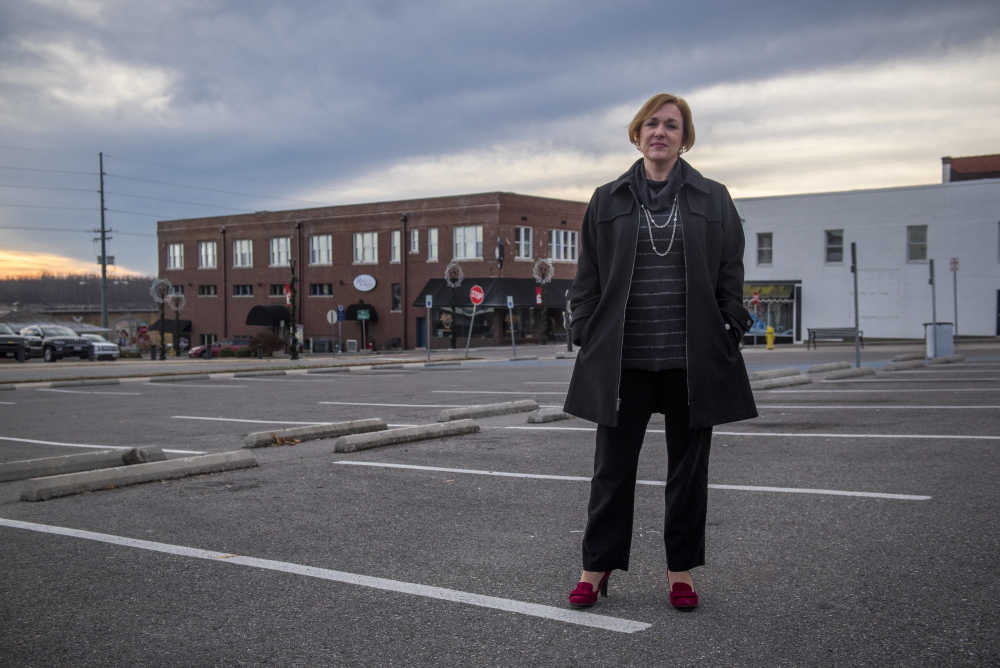Your ideas needed: Local governments increasingly look to public-private partnerships

Cape Girardeau deputy city manager Molly Mehner describes public-private partnerships as integral to city services and targeted economic development in the future: “Cities have to look at different ways of doing things. Resources are more limited. We have less revenue to work with, but we have to provide the same level of service or more. So how do we accomplish that? I think you’re going to start to see not just Cape Girardeau but other cities looking more and more towards the private sector.”
As part of this change, Cape Girardeau has been in the forefront regionally in using Request for Proposals (RFPs) from private enterprise as a mechanism to spark economic activity. Here’s an example: Currently, the City of Cape Girardeau is asking for proposals to redevelop property it owns at 100 Broadway in downtown Cape Girardeau. This prime real estate, located at the corner of Broadway and Main streets, is visible each day to thousands of people traveling to the Isle Casino or historic Cape riverfront. The city doesn’t have the funds to develop what is currently a parking lot, so it’s soliciting “development proposals from qualified developers to redevelop the property.”
The RFP includes a project summary, goals, background and proposal requirements. It also includes clear language that the city is not obligated to accept a proposal or pay for part of any proposal. It also reads: “The prominent corner has high traffic volume, great visibility and good access. Proposals may be in the form of a public-private partnership or a solely private endeavor. The City is open to leasing the property or selling it at a negotiated price following an appraisal to a developer with a successful proposal.”
Deadline for proposals is Dec. 31.
As of B Magazine’s deadline in mid-December, no proposals had been received. But that isn’t unusual, according to Mehner.
“Most of the time, people wait until the 11thhour to submit those things,” she says. But even if no proposals come in, it doesn’t mean the process wasn’t important.
“We believe the private sector has the ability to vet the market and tell us whether or not it’s ripe for development,” Mehner says. “The city has the property, but we don’t necessarily have the means to take advantage of some of the programs out there, the tax initiatives and incentives, that the private sector can. So we think there is tremendous value in opening it up and letting the private sector do the due diligence and determine whether the timing is right.
“We might not get any proposals back at all, but I think there is still value in that because it tells us, A: Either things are churning and burning so well that people are too busy to do anything out here right now, or B: It tells us the timing is not exactly right and maybe we need to let it sit for a bit as parking, and then we’ll come back to it at a later date and try again,” Mehner says.
If proposals do come in, the city will establish a committee to explore the options.
“So typically,” she says, “we will have a committee that will evaluate the proposals. We have criteria laid out in the RFP that we’ll weight and score individually and then come back as a committee and share our responses and determine who rose to the top. At that point, we might shortlist it and bring a few of them in to do a presentation where we can ask a lot of questions. Ultimately, that committee will make a recommendation to the city council on who we think we should enter into a partnership with, but it’s the council’s decision in the end.” Not all of the process will be public, especially during the first review if the developer prefers confidentiality. But the final decision options will be, says Mehner, who stresses the importance of transparency.
The range of proposals
Using RFPs is not new; municipalities do it all the time. Most requests, though, are directed at vendors to provide a specific service. A quick search online, for example, reveals RFPs from local governments for building demolition, digital data storage, road improvements, consulting, sidewalk repair, electrical line relocation and in Sikeston: a request for three “bomb team tool kits” for “complete explosive ordnance disposal.” Want to provide those? Your deadline was Dec. 19.
More and more, though, local municipalities across the country like Cape Girardeau are looking to jumpstart economic development by offering various government incentives to developers to redevelop “targeted” areas (some more targeted than others).
The City of Jackson has an RFP listed for its “Interstate 55 Corridor Tax Increment Financing District.” That RFP reads in part: “The Board of Aldermen … seeks Redevelopment Proposals for the redevelopment area designated in the Plan, which contains approximately 786 acres and is located on both sides of East Jackson Boulevard, and a corridor west of I-55 from East Main Street to the southern boundary of Klaus Park … The City has several objectives for the redevelopment area, which include (but are not necessarily limited to), the following: superior quality development, enhancement of the tax base for the City and other taxing jurisdictions and job creation.”
A project approved in 2017 to take advantage of the Jackson program is a new hotel, according to Jackson Chamber of Commerce executive director Brian Gerau and Jackson Mayor Dwain Hahs. The private developer, hotelier Sam Patel (not to be confused with the restaurateur and Cape Catfish baseball team owner Andy Patel, who is doing a different project at Town Plaza in Cape Girardeau), is delaying construction to time it with a new diverging diamond interchange at the highway.
The City of Perryville is promoting its own “Request for Redevelopment Proposal” in a 1,205-acre area, encompassing much of the land from I-55 into Perryville’s downtown. Its RFP reads in part, “To facilitate the redevelopment of the area, the City will consider the use of tax increment financing and other statutory redevelopment mechanisms. If a proposal includes a request for tax increment financing, the project must demonstrate that ‘but for’ the use of tax increment financing, the project is not feasible and will not be completed.”
Perryville city manager Brent Buerck says there has not been much response to the latest request, but to put things in context, RFPs for redevelopment of Perryville’s downtown were immensely successful.
“We were starting to lose our downtown,” Buerck says, “and we had a 35 percent vacancy rate or worse, really struggling. We were losing the businesses that were on or around the square and replacing them with vacant buildings, and you know, your downtown is kind of your heart. I know that might sound a little corny, but it’s a very important part of a small community.”
Perryville’s downtown RFP offered development and façade grants through tax increment financing (TIF), leading to a dramatic turnaround. Today, businesses on the square are thriving and the area is a hubbub of activity with cruise-ins, motorcycle gatherings, musical performances and other festivals, not to mention a new stage that has become popular for weddings.
“I actually don’t think this all would have happened without us going out for a development proposal,” Buerck says.
In Perryville’s case, TIF projects were the centerpiece of its actions. Cape Girardeau, too, has a broad TIF area in its historic downtown, and several projects have resulted because of it. But Cape Girardeau has also been unique in targeting specific properties – or projects – where it has unusual influence. The corner of Broadway and Main is one example, because the city owns the property. Another involves an area on Good Hope Street, which at the turn of the 20thcentury – 110 years ago – was one of the most vibrant in Missouri. Today, many of the buildings there have been razed or are crumbling. One that collapsed actually turned into an opportunity for the city to guide specific activity.
When the building owner couldn’t pay for demolishing the collapsed building, which was a hazard, the city paid for the demolition and placed a tax lien on the property. The city then used the tax lien as leverage to encourage economic development. It offered to waive the lien if the absentee owner offered the property at no charge to a city-approved development, then the city put out an RFP to seek developer interest. A proposal came in from a development group that included Poplar Bluff-based Dille Traxel, the largest architectural firm between St. Louis and Memphis, to develop the remaining buildings and locate an office there, and the city approved. However, the development group missed a county tax deadline, and another party purchased the property “on the courthouse steps” without knowing about the tax lien. It was a bit chaotic, and not exactly what the city envisioned, but according to Mehner, is all working out.
“We’ve had a few hiccups on that project, but I think it’s going to result in the outcome that we desire, which is to see that corner redeveloped,” Mehner says. The new owner of the building, Robert Janota of ISI Environmental and Recycling, is in conversations with the city about his vision while also working with Dille Traxel’s development group, Alliant Development LLC, which has purchased a neighboring space, according to Mehner. If Janota’s plan is a good one and put into action sooner rather than later, the city expects to forgive the demolition lien, Mehner indicated.
Long history of collaborative projects
In 2004 the successful businessman, consultant and writer John M. Schultz published the book “Boomtown USA: The 7-1/2 Keys to Big Success in Small Towns,” which featured a chapter on Cape Girardeau. Schultz told a state-wide Missouri business conference in 2006, as reported by the Southeast Missourian: Too often, different agencies like the chamber of commerce, city government and universities, let ego get in the way of working together.
“I call it the silo complex,” he told conference attendees. “Most places have a university in one silo, the chamber in another, and the city in another. But in Cape Girardeau, they smashed the silos and worked together.”
Working together on projects like the university’s River Campus, the Show Me Center and on revitalizing downtown is the only way small-town America will make significant strides, Schultz said.
Well, that was then, this is now. Collaboration has moved beyond government entities (or quasi-governmental institutions) simply working together. Now, some kinds of progress demand the development of more private-public partnerships. Or even: the lessening of direct government involvement and the elevation of private solutions with the assistance of government tools.
Let’s review, using Cape Girardeau as an example. The River Campus and Show Me Center, as cited by Schultz, came about by governmental institutions working together. Where there was opposition, it largely came from private developers who questioned the priority and costs of the projects or who had a vested, competitive interest. Then, the city of Cape Girardeau moved into a new phase of developing strategic projects. It would identify a specific municipal goal and then invite others to compete for participation, seeking to create more efficient services and higher quality through a public-private partnership. According to Mehner, the first such project in Cape was likely a new $4 million transfer station, constructed in partnership with the waste-disposal company Republic Services, which opened in 2016. As reported by the Southeast Missourian at the time: “It was well-known among the city staff and city council a new transfer station was needed. There just wasn’t any money to build one.” The public-private partnership created a path forward. A similar closed but collaborative process was subsequently used for building a convention center (adjoining a new Drury Plaza hotel) in Cape Girardeau after such a facility was cited by a city study group as being a top goal.
It was around the same time as the convention center that the city employed an RFP in a new way, to determine whether there was private interest to help build an indoor sportsplex, for which the city had funds thanks to the extension of a hotel-motel tax. Mehner, who previously had been part of a large stadium project in Arizona that had successfully solicited business involvement, brought the idea to Cape. In this case, the city wasn’t sure what the private interest would be and put an RFP together to determine possibilities. The market responded with several attractive options. The result: a bigger and better facility, located at a prime spot off the highway, than what the city could have done on its own. Cape is currently deliberating RFP responses around another large product: a new aquatic center.
“I’m not involved in this particular process and am not on the committee,” Mehner says about the aquatic center RFP, “but from my perspective, I think you know there were a lot of people saying it was all predetermined between the school and the city, and that’s not the case. We’ve always said if somebody will bring something to the table, we’ll absolutely entertain any proposal out there. That’s our intent: Put it out there and see what other ideas people have. You hope to get several responses, and in this case the number of responses wasn’t as robust. But options have been presented, and that’s the whole point, learning if there is a better way to reach a goal.”
In each of the cases, the city brings an influence to the table: TIF designation, tax money, the ability to waive a tax lien, property it would sell to the right development. According to Mehner, that influence makes it vital to use a transparent process, and RFPs help with that.
“Citizens are both more engaged and less informed nowadays, in part because of social media. They have a lot more exposure to things that are going on locally that they might not have known about before. So, they may have an idea about a project, but not really the depth of knowledge,” she says. As a result, the city sees people questioning city projects through the use of social media.
“It’s all the more important for us to be transparent about these processes and how we do things,” Mehner says, especially because such projects are going to be even more prevalent in the future. “It’s important people understand and trust the process.” Otherwise, potential is missed; growth opportunities lost.
Mehner credits strong local strategic planning – which creates working documents and not just something that gathers dust on a bookshelf – for much local progress, as well as the maintenance of smooth local relations.
“It seems to be working,” she says. “The partnerships that are in place in this community are just phenomenal. It’s something that I haven’t experienced elsewhere, where it seems the city is always at odds with various groups who may say they want to work together, but everybody wants to have their own way. Here, we don’t always agree, but we listen, keep the process open, and it’s refreshing how well it works. It’s fun to work and do these projects together.”
The future: more such projects to come.
































